U.S. Department of Transportation
Federal Highway Administration
1200 New Jersey Avenue, SE
Washington, DC 20590
202-366-4000

Best for printing: rsa_winter2012.pdf (1.11 MB)
To view PDF files, you can use the Acrobat® Reader®.
By Becky Crowe, RSA Program Manager
FHWA Office of Safety
As another year begins to wind down, Road Safety Audit (RSA) activity across the nation has done just the opposite. As of October 2011, 16 States have now established a formal RSA Program and all 50 States as well as Puerto Rico and the District of Columbia have piloted or perform RSAs. Craig Allred of the FHWA Resource Center has been on the road and hard at work. In Fiscal Year 2011, Craig conducted over 26 trainings, which were attended by over 500 students. To highlight all Craig's hard work, we have included a new section in the Newsletter called, "Where is Craig?" Please check it out! I hope you enjoy our newsletter and a special thank you to Brian Walters, Jeff Shelton, Steven Buckley and Matt Buchanan, our guest authors for sharing their experiences with RSAs.

| For more information, please visit: http://safety.fhwa.dot.gov/rsa or contact Becky Crowe, FHWA RSA Program Manager Rebecca.Crowe@dot.gov |
By Brian Walters, PHOTOSafe Program Coordinator
 |
| "RSAs support the mission of the City of Virginia Beach which is to enhance the economic, educational, social and physical quality of the community; and provide services that are valued by its citizens." – Master Police Officer (MPO) Brian Walters Virginia Beach Police Department |
The RSA training conducted in the City of Virginia Beach has been labeled a success for the region on many levels because the process has been used to assess a myriad of transportation challenges. The city hosted FHWA's two day Road Safety Audit training, which comprises both classroom instruction and a field exercise, at the City's Advance Technology Center on May 31, 2011. All cities in the Hampton Roads region, located in southeastern Virginia, were invited to participate in this training opportunity. Attendees comprised a multi-disciplinary group representing Public Works, Traffic Engineering, and Police Departments from the cities of Virginia Beach, Chesapeake, Newport News, Hampton, and Norfolk, as well as the Virginia Department of Transportation. Virginia Beach traffic managers were especially interested in the comments provided during the field exercise because the team visited and assessed one of the city's red light camera enforced intersections. Anyone from the Virginia Beach trained team can initiate an RSA. So far, four RSAs have been completed with Traffic Engineering, Public Works, Parks and Recreation, and the Police Department each initiating one.
The completion of RSAs using an existing pool of internal experts is expected to save the city a sizeable amount of money that can be allocated to funding improvements. Many of the RSA team members have the ability to generate immediate action to correct many of the safety or low cost items that are identified. Jonathan Paxson, Traffic Signal Electronics Supervisor of the Public Works Traffic Management and Operations Division, notes "having a group of highly trained RSA members visit and evaluate the target area is essential to the process, but it is also important to solicit input from people who live in the community. The residents know the area best and can explain any anomalies that are occurring during the day or night time hours." Senior Traffic Engineer Mike Shahsiah observes that, "RSA teams catch the attention of the community; people see them wearing safety vests and they get curious; they want to know what's going on." In addition to all the benefits that have been seen as a result of the RSA training, RSAs truly support the mission of the City of Virginia Beach which is to enhance the economic, educational, social and physical quality of the community; and provide services that are valued by its citizens.
For more information about Virginia Beach RSA activities, please contact:
|
MPO Brian Walters |
Mike Shasiah, P.E. |
Jonathan Paxson |
By Jeff Shelton, Assist. Research Scientist
In the summer of 2010, the Texas Transportation Institute (TTI) conducted a road safety audit (RSA) on the Loop 375/SH 20 Alameda interchange in El Paso, Texas. The Texas Department of Transportation (TxDOT) wanted to determine how short, mid and long-term strategies affect the transportation system and if improvement projects would be eligible for TxDOT's Hazard Elimination Safety funds.
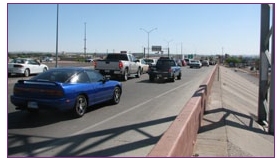 IMAGE COURTESY of Jeff Shelton |
TTI used a multi-resolution modeling (MRM) methodology to supplement the conventional safety audit process. The MRM approach used both mesoscopic (DynusT) and microscopic (VISSIM/Synchro) simulation-based models to evaluate the project limits at both the corridor and localized levels for current and future years. The MRM process allowed the RSA team to analyze whether each improvement strategy had positive or negative impacts to traffic flow patterns (i.e. did they simply shift the problems elsewhere). It must be noted that simulation modeling was not used to "predict" traffic crashes, but rather analyze the interactions of vehicles through the analysis of surrogate measures (e.g. deceleration rate, speed differentials and queue length).
The audit team first collected data in the form of traffic counts, turning movements, vehicle composition percentage, signal timings and historical crash data. The data collection helped auditors understand traffic patterns and was used to calibrate the simulation-based models. The crash data revealed several locations that experienced a high frequency of crashes including freeway off ramps where vehicles routinely queued back onto freeway main lanes during peak periods. The audit team spent several days analyzing the interchange including on-site visits during peak and non-peak hours. Multiple mitigation strategies were identified ranging from signal timing optimization, reconfiguration of lane assignments, access management strategies on abutting driveways, and proposed infrastructure construction.
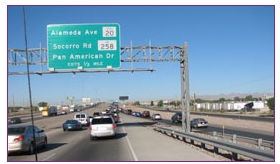 IMAGE COURTESY of Jeff Shelton |
The mesoscopic DynusT model was used to analyze several different roadway construction projects including a proposed new off ramp downstream of the existing interchange. Since the meso model utilizes a dynamic traffic assignment algorithm, it was able to show how traffic is shifted to alternate routes and whether proposed improvements transferred the traffic problems to alternate locations. A sub-area of the meso model was then extracted and converted to a microscopic counterpart where all paths and flows were retained within the boundary area. A Synchro model was used to determine if the signal timings were running at optimized levels. This also allowed the team to analyze different lane configurations. In addition, the audit team modeled the freeway main lanes in VISSIM with the right shoulder used as an auxiliary lane. Once all scenarios were modeled, the simulation results were included in the RSA final report. TxDOT is currently moving forward with several recommendations including transforming the right shoulder lane on the freeway into an auxiliary lane.
The MRM process gave premise on traffic conditions for each proposed improvement strategy and how traffic redistributed to alternate routes. This in turn allowed for a more complete analysis by providing insights about locations that might be adversely affected by proposed improvements. Incorporating MRM into an RSA gives roadway agencies a better understanding of how short, mid and long-term strategies affect the transportation system now and in the future.
For more information about this Texas RSA, please contact:
Jeff Shelton, Assistant Research Scientist
Texas Transportation Institute
(915) 532-3759
j-shelton@tamu.edu
By Steven Buckley, State Hwy. Safety Engineer
 IMAGE COURTESY of TranSystems |
Kansas, with a population of 2.8 million, ranks third in the nation in miles of public road with over 140,000 miles. The others in the top four are Texas, California, and Illinois, with a combined population of 74.7 million. In other words, Kansas has a lot of miles and not a lot of people. The challenge for the Kansas Department of Transportation (KDOT) is managing safety and targeting investments on such a large system. One tool KDOT is turning to with greater frequency is the RSA. In 2010, KDOT piloted a county corridor RSA in Saline County, home of the City of Salina (population 46,180). The 11 mile study segment, Country Club Road between the Salina City Limits and Solomon Road (Dickinson County Line), was submitted for evaluation by Saline County in response to KDOT's call for a volunteer county for this pilot project. This county highway is typical of many throughout the state: two-lane asphalt, little or no shoulder, and intersected by a gravel township road about every mile.
While KDOT has championed the road safety audit concept for years, this is the first corridor-level RSA conducted in the state that stays true to the definition of an RSA: a formal safety performance examination of an existing road or intersection by an independent, multi-disciplinary assessment team. KDOT focused on safety and followed a formal process, with specific procedures and documentation. Through the use of a consultant out of Kansas City, KDOT performed a detailed crash analysis, met with local officials, conducted a field review, collected necessary field data, developed recommendations, met again with local officials, and prepared a final report. The review team included a representative from LTAP, a former county engineer, two former state highway patrol troopers, two state traffic engineers, and a consultant.
The study was funded in part with federal and state safety dollars and recommendations from the study are eligible for High Risk Rural Road Program (HRRRP) funding. Based on the success of this study, any county highway corridor that appears on KDOT's annual Transparency (5%) Report automatically qualifies for an HRRRP funded RSA. From there, recommendations from an RSA that target a correctable crash pattern are eligible for HRRRP construction dollars. Recommendations could be low-cost, such as improved pavement markings or new signs, or higher cost, such as improved shoulders or removal of fixed-objects. Through the use of RSAs KDOT has found a mechanism to obligate HRRR Funds.
For more information about the Saline County RSA, please contact:
Steven Buckley, State Highway Safety Engineer
KDOT Bureau of Transportation Safety & Technology
(785) 296-1148
buckley@ksdot.org
By Matt Buchanan, Community Development Planner
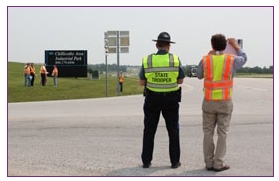 IMAGE COURTESY of Mo-Kan Regional Council |
Three Regional Planning Commissions (RPCs) in northwest Missouri have recently partnered with each other to initiate a regional RSA program. The Mo-Kan Regional Council in St. Joseph, the Northwest Missouri Regional Council of Governments (NWMORCOG) in Maryville, and the Green Hills Regional Planning Commission in Trenton partnered with FHWA and the Missouri Department of Transportation (MoDOT) to ensure the success of their RSA program.
The process of initiating an RSA program began when Mo-Kan contacted FHWA about coordinating a training workshop in St. Joseph. FHWA provided the two day training to planners, traffic engineers, and elected officials who were taught the basic concepts needed to perform formal RSAs. During the second day of the training, workshop participants traveled into the field to conduct "mini" RSAs, where they could put their newly acquired skills to the test. After the training, RPC planners felt fully prepared to pursue a comprehensive RSA program to benefit the greater northwest Missouri region.
| The Northwest Missouri Regional RSA Program was recently awarded an Excellence in Regional Transportation Award through the National Association of Development Organizations (NADO). |
The RPCs also took advantage of FHWA's RSA Peer-to-Peer (P2P) program to conduct their first audit in June, which took place at an intersection outside Chillicothe, MO. Kevin Murphy, a Transportation Planner with the Delaware Valley Regional Planning Commission (DVRPC) in Philadelphia, PA traveled to Missouri to help coordinate the Chillicothe RSA. "I was excited to have been selected for the P2P program, but never expected to get more out of it than I gave. Working with the great folks of Chillicothe and the local planning agencies was a fun learning experience, and from it I gained a new perspective on the RSA process that will be valuable in my work in the Philadelphia area." Mr. Murphy made a good resource for the northwest Missouri RPCs, not only because of his experience conducting RSAs, but also because he too focuses on regional planning through his work at DVRPC.
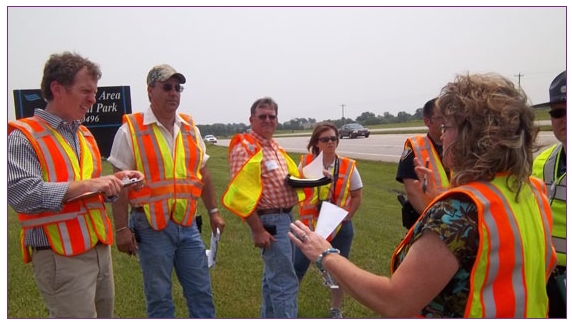 IMAGE COURTESY of Mo-Kan Regional Council |
According to Tom Bliss, Mo-Kan's Executive Director, "RSAs are a natural fit with RPCs. Our Transportation Advisory Committees (TACs) are made up of local citizens and elected officials who are tasked with identifying the region's transportation priorities, including safety concerns. With their input, we can identify the roadways that are in most need of a safety examination."
RPCs are also practical organizations to conduct RSAs because they can offer resources afterward to help implement the safety improvements suggested in the RSA report. Bliss notes, "After the reports are complete, the affected communities may work with their designated RPC to identify funding sources for safety improvements." Mo-Kan, NWMORCOG, and Green Hills will also work with MoDOT officials to determine how the DOT might implement improvements. High dollar improvements may also be addressed through the RPCs' annual transportation needs prioritization process, which influences the Statewide Transportation Improvement Process (STIP).
Mo-Kan, NWMORCOG, and Green Hills will coordinate three RSAs per year, with one being conducted in each RPC region. Together, the three RPCs make up the 20-county area of the Northwest MoDOT District.
For more information about the Northwest Missouri Regional RSA Program, please contact:
Matt Buchanan
Community Development Planner
MoKan Regional Council
(816) 233-3144
matt@mo-kan.org
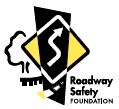 Craig Allred, FHWA Resource Center RSA instructor, gave a presentation on RSAs to the Roadway Safety Foundation (RSF) Advisory Committee in Washington, DC on October 26, 2011. RSF is a national organization dedicated to reducing deaths by improving the physical characteristics of roadways. Craig's presentation included an overview of the RSA process and the benefits of using this proven countermeasure. Advisory Committee members then applied their new RSA knowledge to identify opportunities for safety improvements in pictures of roadways and intersections.
Craig Allred, FHWA Resource Center RSA instructor, gave a presentation on RSAs to the Roadway Safety Foundation (RSF) Advisory Committee in Washington, DC on October 26, 2011. RSF is a national organization dedicated to reducing deaths by improving the physical characteristics of roadways. Craig's presentation included an overview of the RSA process and the benefits of using this proven countermeasure. Advisory Committee members then applied their new RSA knowledge to identify opportunities for safety improvements in pictures of roadways and intersections.
The Idaho Transportation Department released an RSA Manual in June. The manual is available online at http://itd.idaho.gov/manuals/Online_Manuals/Current_Manuals/RSA/ITD%20RSA%20Manual.pdf.
The Rhode Island DOT has initiated a Pedestrian RSA Program. The focus this summer and fall was on towns with beach areas and village settings. In spring 2012 the focus will shift to university areas, and then following up with other high pedestrian locations.
|
To highlight your agency's RSA in the newsletter
or to learn about upcoming RSA training activities contact: For more information on the Road Safety Audit
Peer-to-Peer Program: |
The Bicycle RSA Guidelines and Prompt Lists were piloted in Atlanta, Georgia in September on Ponce De Leon Avenue and Highland Ave. The guidelines and prompt lists will be piloted again on the Mount Vernon Trail in Arlington, Virginia in November.
Work Zone RSA Guidelines and Prompt Lists are now under development and will be finalized by August 2012.
Have any of your RSAs used Crash Modification Factors (CMFs) either in the RSA report or during the implementation of suggestions from the RSA? If you integrate CMFs in your RSA process, please send the agency name, primary contact information, and brief description of how the agency is using CMFs to Karen Yunk at Karen.yunk@dot.gov.
Below is a map showing the status of RSAs across the US. Do you have other information on RSAs to report for your state? Please let us know!
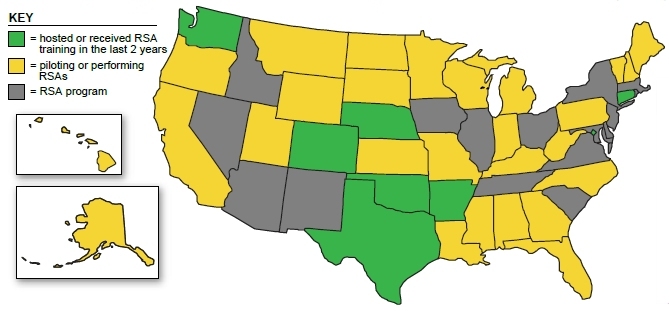
| The FHWA Office of Safety's mission is to reduce highway fatalities by making our roads safer through a data-driven, systematic approach and addressing all "4Es" of safety: engineering, education, enforcement, and emergency medical services. Increasing awareness of the need for roadway safety infrastructure improvements is very important. We are striving to provide decision-makers with important information, tools and resources that will improve the safety performance of roadways. Safety should be considered first, every time and at every stage of a project. Make safety your first consideration in every investment decision. |
